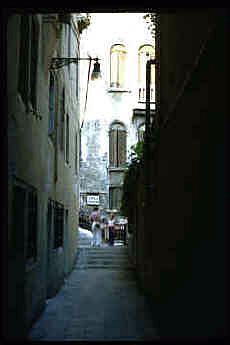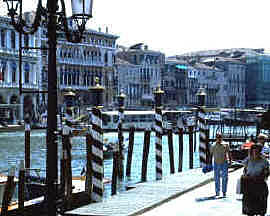SAYING GOODBYE TO VENICE |
|
Harlan Hague |
I went to Venice to say goodbye. The last time I was there, I was satisfied that I had wrung from Venice all that it had to offer. I had enjoyed the visit, but left with the firm conviction that I would be bored if I went back, and that would tarnish the memory.
Some friends who had never been to Venice prevailed on me. They reminded me what I had said: everyone should see Venice, once. Reluctantly, I agreed to accompany them.I showed them the main sights, and then they scattered, sightseeing and shopping. I was left standing in the center of the Piazza San Marco, where we had ended our tour.
I didn't know what to do with myself. Since I had nothing planned for the afternoon and nothing I wanted particularly to do, I put my map in my pocket and started walking. And I rediscovered Venice.
I strolled down narrow passageways and across canals. The farther I walked from Piazza
San Marco, the fewer tourists I saw. At length, I rounded a corner and stepped
unexpectedly into a large, almost empty square, the Piazza Santa Maria Formosa.
the fewer tourists I saw. At length, I rounded a corner and stepped
unexpectedly into a large, almost empty square, the Piazza Santa Maria Formosa.
There were two fruit stands in the center of the piazza. I bought an apple and a peach, washed them in a public fountain nearby and sat in the shade of the church to enjoy my lunch. The sun had been most welcome an hour ago, but now it was quite warm. Heat radiated from the concrete floor of the square.
Red and white umbrellas over the tables of the two small cafes accentuated the grays and tans of the buildings. The tables were lightly occupied, though it was noon. Houses and a few shops lined the piazza. At the far end was what at one time had been a fine mansion, now in splendid decay.
Few people passed, mostly local people. They bought fruit, stopped briefly under awnings to chat, then disappeared into dark openings in the solid wall of buildings that lined the square.
I stayed an hour, enjoying the respite from the crowds at Piazza San Marco. That tourist magnet seemed miles away, though it was but a ten-minute walk.
I resumed my wandering, still ignoring my map. I passed down narrow alleys, discovering
quiet, little  piazzas and cul-de-sacs where laundry hung from windows
and occupants watched me from balconies. It was a Venice I had not seen before, indeed had
not known existed.
piazzas and cul-de-sacs where laundry hung from windows
and occupants watched me from balconies. It was a Venice I had not seen before, indeed had
not known existed.
As I continued, the lanes became more crowded, houses gave way to shops, and eventually I reached the Grand Canal and the Rialto Bridge. For the next hour, I sat at a table at the canal's edge, shaded by a brightly-colored umbrella, sipping wine and watching the traffic. There was the human sort, mostly tourists, some ambling, the best pace for Venice. Others seemed frantic to get someplace. The latter, unfortunately, is more typically the pace of the tourist.
Mostly, I watched canal traffic. Not just the vaporetti, the canal buses, and gondolas--midday on the busy Grand Canal is not the best time for a romantic gondola ride--but also the police boats, delivery boats, boats carrying construction equipment and construction waste. It was a parade of tourists at play and Venetians at work.
That afternoon, Venice became for me more than it had been before, not just a magnificent relic, but a place where people live. It was that different way of living that now fascinated me as much as the antiquity of the place.
My eyes thus opened, I took a new look at Venice's attractions. I even took a gondola ride. I had never been in a gondola, but late that evening I had a ride and loved it. We glided down narrow, softly-lit canals and rafted with three other gondolas on the Grand Canal. A baritone and an accordionist entertained with Venetian melodies and surprised a member of our party with "Happy Birthday." It was a birthday he would never forget.
 Though I now see Venice in a new light, I am still not enamored with the crowds that
choke the central city in the summer. Next time, I'll go in late spring or early autumn.
Or winter. I would love to see Venice under a dusting of snow.
Though I now see Venice in a new light, I am still not enamored with the crowds that
choke the central city in the summer. Next time, I'll go in late spring or early autumn.
Or winter. I would love to see Venice under a dusting of snow.
See Venice at any season. If you can go only in the summer, do it. By all means, go to the Doges Palace--take a tour with an English-speaking guide, or read the brochure first--visit St. Mark's Basilica, and see the view from the top of the Campanile. Even go to a glass "factory." In the evening, take a gondola ride, then return to the Piazza San Marco to relax, sip an espresso and listen to any one of a number of orchestras play in the distinctive Venetian style.
Having done all that, slow your pace. Put your map aside, and amble. Sit down for tea or wine at a sidewalk cafe whenever it strikes your fancy. Resist the mysterious malady which seizes the traveler in a moment of repose and says: "Do something!" The most treasured memories, indeed, are most often these rare, delicious moments of repose.
Venice, more than any other popular tourist destination, puzzles the first-time visitor who looks below the surface. Why was it built on islands? Why is Venice different from other Italian cities? What or who were Doges? Where did the Venetians get the fabulous wealth necessary to build such magnificent structures? Why does St. Mark's have an eastern look about it? All these questions can be easily answered in a good history of Venice. Check your local library.
|
Caveat and disclaimer: This is a freelance travel article that I published some time ago. Some data, especially prices, links and contact information, may not be current. |
|
|
|
|